Q1. Manoj’s monthly salary is 25% more than Mohit’s salary. Mayank’s monthly salary is Rs 1750 more than Mohit’s monthly salary. Sum of Manoj’s, Mayank’s and Mohit’s yearly salary is Rs 3,33,000.
Quantity I: Sum of monthly salary of Manoj and Mohit together
Quantity II: Rs. 20,000
(a) Quantity I > Quantity II
(b) Quantity I < Quantity II
(c) Quantity I ≥ Quantity II
(d) Quantity I ≤ Quantity II
(e) Quantity I = Quantity II or No relation
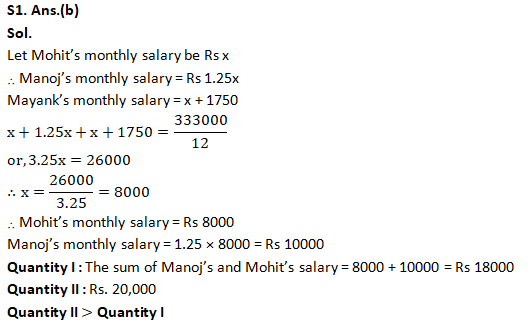
Q2. A bag contains 8 white balls, 13 black balls and 5 green.
Quantity I: Probability that the first ball is white and the second ball is black if two balls are drawn at random from the bag one after another without replacement.
Quantity II: 6/35
(a) Quantity I > Quantity II
(b) Quantity I = Quantity II or No relation
(c) Quantity I ≥ Quantity II
(d) Quantity I < Quantity II
(e) Quantity I ≤ Quantity II

Q3. Quantity I: Profit share of ‘A’ out of total annual profit of Rs. 56,500. A, B and C enter into a partnership. ‘A’ invests Rs. 4000 for the whole year, ‘B’ puts in Rs. 6000 initially and increased to Rs. 8000 at the end of 4 months, while C puts initially Rs. 8000 but withdraw Rs. 2000 at the end of 9 months.
Quantity II: Amount which when lend on C.I. at 20% interest being compounded annually for 3 years, gives total interest equal to Rs.9100
(a) Quantity I > Quantity II
(b) Quantity I ≥ Quantity II
(c) Quantity I < Quantity II
(d) Quantity I = Quantity II or No relation
(e) Quantity I ≤ Quantity II

Q4. 8 men and 4 women together can complete a piece of work in 6 days. Work done by a man in one day is double the work done by a woman in one day. 8 men and 4 women started working and after 2 days, 4 men left and 4 new women joined the work.
Quantity I: Number of days required to complete remaining work after 4 men left
Quantity II: 5 days
(a) Quantity I = Quantity II or No relation
(b) Quantity I ≥ Quantity II
(c) Quantity I < Quantity II
(d) Quantity I ≤ Quantity II
(e) Quantity I > Quantity II

Q5. The ratio of the age of Tina and Rakesh is 9 : 10 respectively. Ten years ago the ratio of their age was 4 : 5 respectively.
Quantity I: 22 years
Quantity II: Present age of Rakesh
(a) Quantity I > Quantity II
(b) Quantity I < Quantity II
(c) Quantity I = Quantity II or No relation
(d) Quantity I ≥ Quantity II
(e) Quantity I ≤ Quantity II
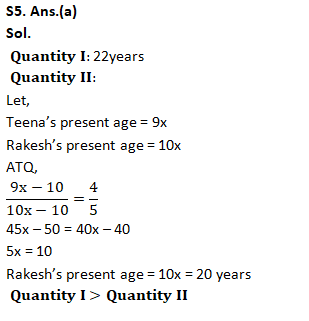
Directions (6-10): Pie-chart given bellows shows the income of five different persons and bar graph shows the percentage distribution of their income on different things. Study the question carefully and answer them.
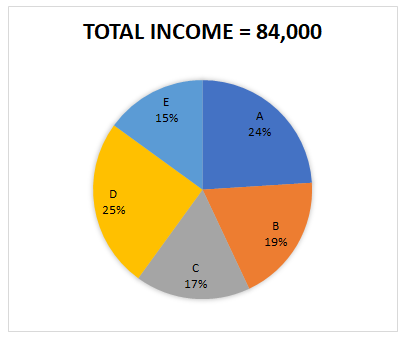

Q6. Who among the following spend maximum amount on food?
(a) D
(b) E
(c) B
(d) C
(e) A

Q7. Amount spend by ‘E’ on furniture is what percent more than amount spend by ‘D’ on Transportation?
(a) 70%
(b) 45%
(c) 80%
(d) 65%
(e) 60%
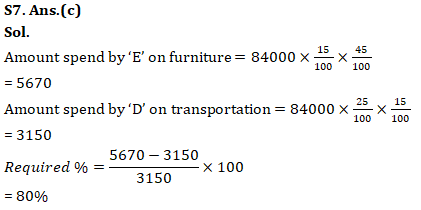
Q8. Find the average amount spend by A, B and C on furniture?
(a) 4622
(b) 4626
(c) 4262
(d) 4266
(e) 4662

Q9. ‘D’ buy only three type of food X, Y and Z and amount spend on buying X, Y and Z is in the ratio 5 : 7 : 8. What is the difference between amount spend on buying Z type food to amount spend on buying X type food.
(a) 2520
(b) 1680
(c) 8400
(d) 1260
(e) 2100

Q10. Find the ratio of amount spend by ‘A’ and ‘B’ together on food to the amount spend by ‘C’ and ‘D’ together on furniture?
(a) 295 : 277
(b) 277 : 295
(c) 310 : 301
(d) 301 : 305
(e) 301 : 310
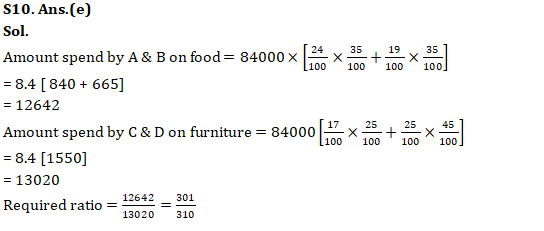
Directions (11-15):-Find the wrong number in the given number series questions.
Q11. 900, 648, 516, 452, 420, 404, 396
(a) 396
(b) 900
(c) 404
(d) 648
(e) 452

Q12. 8, 4, 4, 8, 32, 136, 812
(a) 8
(b) 136
(c) 32
(d) 812
(e) 4

Q13. 3, 11, 49, 191, 569, 1135, 1134
(a) 1135
(b) 1134
(c) 3
(d) 49
(e) 11

Q14. 23, 30, 42, 63, 95, 140, 200
(a) 42
(b) 140
(c) 30
(d) 200
(e) 23
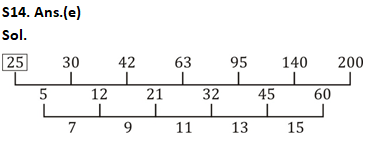
Q15. 8, 30, 60, 120, 180, 180, 90
(a) 30
(b) 120
(c) 90
(d) 8
(e) 60

For 200+ most important arithmetic questions

- Quantitative Aptitude Study Notes for Bank Exams
- 100 MCQs Data Interpretation | Download Free PDF’s of DI
- Quantitative Aptitude Questions for all Competitive Exams
All the Best BA’ians for IBPS RRB PO/Clerk Main





 GA Capsule for SBI Clerk Mains 2025, Dow...
GA Capsule for SBI Clerk Mains 2025, Dow...
 The Hindu Review October 2022: Download ...
The Hindu Review October 2022: Download ...
 I Failed To Crack SBI PO, What Next?
I Failed To Crack SBI PO, What Next?





